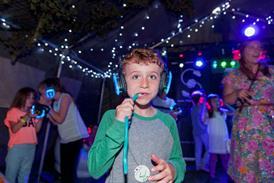
In the last article I began what I hope will be an ongoing debate in this magazine. In case you missed it, the long and short of it was this: we have lived in a paradigm of children’s work where we are primarily educators for too long, and this model - if we’re really honest - hasn’t been working. We need to find something new that will radically change the way we do things. In this article I want to try and explore a little of what this new paradigm might look like. This is hugely risky; we’ve all read those lists of bold predictions made about the future that proved wildly wrong. (Such as the man at IBM who reckoned the global market for computers would be about five.) To defend myself from this, I’m going to try and be broad and deal in principles rather than the specifics of resources, traditions and practices which need to change. The reason for this is because I don’t think that the future of children’s work lies with one particular resource, tradition or denomination. Just as the core principle has been to educate children, we need to find the core of our new paradigm and then apply that appropriately in our various contexts.
So what will be the keys to a new paradigm?
Encountering God, not learning about him
It’s an oft-quoted statement about children’s ministry that you can contrast the experience of an adult and a child in a church as one coming to encounter God, and one coming to learn about him. This needs to change; children’s ministry must have as its primary function the creation of opportunities for children to encounter a living God.
As I said in my first piece, the key to this is going to be us realising that children are made in God’s image, and are already compatible with God; we don’t need to tell them what to do even if the educator in us wants to do that. We just need to get out the way and give them the space to find God for themselves. We can give them tools that will help and spiritual practices that will allow them to connect with God wherever they are. This is a very powerful idea as it leads to children who carry this spiritual toolkit into their lives, and ensures that children aren’t dependent on us or our meetings to find God.
We may find that we need to dig out some ideas that have fallen away from children’s work in the past, even some of Christianity’s most ancient practices. The idea of monks alone in caves praying seems very detached from a modern children’s group - but I’ve built little ‘caves’ out of tables for the children in my group to go in and spend time with God. The comments from the children and their parents afterwards were amazing, and I have colleagues who have had similar experiences in their groups. The most amazing part of this was a parent telling me that they found their child hiding away in their room in order to recreate the experience and the encounter with God. Something special had happened; it was more than just an amazing time in the session, they had found a way of finding God for themselves and so had gone there to find him again.
The funny thing about the caves was that I had no way of manipulating what was going on. I had to trust God, and although we spoke to the children afterwards I had no way of knowing the profound impact it was having on the children. I couldn’t have a quiz to check they had done it right and I couldn’t try and measure it. In fact it would be wrong to try, as such is the power I wield as the adult in the group that it would have limited them to an experience which fitted my template, with them probably just telling me what I wanted to hear, to please me.
If we can get this right we have the potential of seeing a generation of children growing up in our churches who, as Ivy Beckwith so wonderfully puts it, have ‘never known anything other than relationship with God’. I would add that they will be equipped with the tools to find God for themselves.
Learning to think theologically, not learning stories
I said last time that we are teaching children not to think for themselves and merely asking them to show that they can remember our thinking. The problem with this is that children never learn to feed themselves from the Bible as they are dependent on us. We need to think differently about this; we need to give children frameworks to find their own way around Bible stories and find where the story can speak into their lives, without needing us to do it for them. The way we do this is to think about giving Bible stories as gifts for children to have as resources for their whole lives, not simply as visual aids to a teaching point we are trying to make.
Children can find such depth in a Bible story that we can’t really see because they handle stories differently to us. If we give them the answers we shut this off. We tend to stand back from a story and consider it’s meaning in an abstract way, whereas children jump into points of the story and explore what’s happening in the moments that feel significant to them, and often where they have parallels into their own experiences or feelings. So to take the story of David and Goliath as an example: as an adult I would probably take a step back and say it tells me that when things seem impossible, God can help me overcome. Most Sunday School resources will tell me this application point - but a child will want to explore the story itself, and may find meaning in thinking about the child left behind while his brothers went to fight, or even in the reluctant king trying to hide from his responsibilities and sending a child into battle dressed as him.
The key to opening up stories is to ask open-ended questions which draw the children into the story. This is why Godly Play is wonderful and plays into this so powerfully (see p. 22 for more info about Godly Play), but in reality any questions that help the children to think rather than recall facts are brilliant. If you do this I guarantee it will change your life with God as well; there is so much you will learn as you listen and think about things with the children, allowing their insights to shape your thinking.
Once we get children thinking about God for themselves it opens up a new way of talking about the morals we need to live well; we don’t need to spoon feed this to them either. There is a danger that our moral teaching can be a way in which we conform children to cultural expectations. We need to show them what the Bible says but not be so prescriptive that children don’t get to think about it. This will resource them to be able to think for themselves and make good choices when we can’t be there to tell them what to do - on the playground at school or as they grow older and go to university or work. We need children to know what it means to live the principles of the kingdom of God and not the rules of the Church.
Out of a school and into a community
When I go around the diocese I work in I am staggered by how many groups don’t feature what for me is the most important part of any group. In the rush to fit in a good craft to take home and get all the story done they have dropped having a drink, a biscuit and a chat. When I tell them this they think I’m mad. And yet John Westerhoff (one of the greatest children’s ministry thinkers of our time) tells us that faith grows in Christian community. Faith is about being connected to God and to his people, so there must be a part of your session where community is formed, news is listened to, needs are prayed for, they can tell you about their rabbit, and children can serve one another and be served; all of this is crucial. It is the very foundation on which all the other work you’re doing sits.
I believe that making our groups age specific has undermined this sense of community. In a school you want children of similar ages to learn together but in a community children need to be gracious towards each other’s differences and help one another out, with the older ones helping the younger ones. That is what churches are supposed to be like - we are not consumers at church but part of a community and our children must experience this in our groups too.
There is of course a final step in the joining of children into the body of the Church, and that is getting them out of our groups and into the place where the adults hang out. When Westerhoff says community he’s talking multi-generational; so no matter how well we do it, Children’s church is not the answer. We need to be proactively engaging children into the life of the Church, which means putting children on the tea and coffee rota, inviting boys to the men’s breakfast, and allowing children’s voices to be listened to at leadership level. This will take a long time to change but we must fight to see it happen. In the meantime we must do all we can to make our groups communities where children feel that they belong. Remember: children will remember your name longer than your sessions!
I hope I have got you thinking about another way forward, where we don’t re-invent old methods but instead step into something new and exciting. Here children are given the tools they need to live a life of relationship with God, able to live for him in many new contexts, feeding themselves from the resources of the Bible and welcomed into the heart of the community of his people. So let’s be part of this change. Start trying out some new ideas, take some risks and be part of something that changes our bit of the Church forever.
FEEDBACK Do you agree with Sam? Send your thoughts to childrenswork@premier.org.uk




























